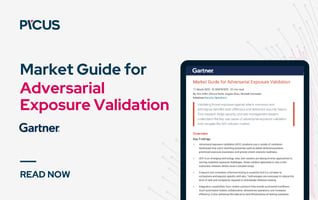Picus Exposure Validation: Stop Treating Every CVE Like a Crisis
A vulnerability with a CVSS score of 9.8 may be a 4.0 in your environment.
The Picus Exposure Score reveals your actual state instead of relying on
a theoretical risk score.
The Vulnerability Management Crisis You Can’t Ignore
More than 40,000 vulnerabilities (CVEs) were disclosed in 2024. Of those, 61% were marked “high” or “critical.” However, in the real world, only a small fraction of them will ever be successfully exploited. Especially against well-defended environments.
Which begs the question: Why are security teams still so overwhelmed with patching queues and overwhelming pressure to meet their SLAs?
Well, traditional approaches like CVSS, EPSS, and KEV can’t factor in the unique nature of your organization’s defenses. They don’t know your security controls, the criticality of your assets, or your organization’s specific threat environment.

The Limits of Traditional Prioritization
Security teams are expected to patch thousands of vulnerabilities and exposures every year. Yet, they usually lack the context they need to know which ones truly pose a risk.
-
CVSS measures theoretical severity, not actual exposure.
-
EPSS predicts exploitation likelihood, but ignores your defenses.
-
KEV flags exploited vulnerabilities, but not whether your controls can stop them.
Without context, everything looks urgent. The result? Over-prioritization, alert fatigue, wasted effort, and the likelihood of real threats remaining undetected, buried under noise.
Introducing Picus Exposure Validation
Picus Exposure Validation (EXV) replaces assumptions with evidence. It continuously simulates real-world attacks, including vulnerability exploits, against your live environment to validate which exposures are truly exploitable.
At the core of EXV is the Picus Exposure Score (PXS), a dynamic, evidence-based metric that accounts for:
-
Vulnerability severity (e.g., CVSS)
-
Exploit availability (e.g., EPSS, KEV)
-
Measured effectiveness of your controls
-
Asset importance and business context
PXS helps teams confidently de-prioritize theoretical risks and focus on vulnerabilities that matter right now.
How It Works
-
Collect Environment and Vulnerability Data
Picus Exposure Validation starts by ingesting key context about your environment, including CVEs, CVSS scores, EPSS predictions, asset inventories, and control configurations.
-
Simulate Real-World Attacks
Using threat behaviors mapped to the MITRE ATT&CK framework, Picus simulates the full kill chain, including initial access, privilege escalation, lateral movement, exfiltration–and all other tactics along the way against your actual defenses.
-
Measure Control Effectiveness
We evaluate each simulated attack step across your security stack (SIEM, EDR, NGFWs, IPS, etc.) to determine whether it will be blocked or missed, providing accurate indicators of your controls, and their performance, in real-world conditions.
-
Calculate Picus Exposure Scores (PXS)
Picus Exposure Validation (EXV) assigns a Picus Exposure Score (PXS) to each vulnerability based on security control effectiveness, CVSS score, exploitability (via EPSS, KEV, etc.), asset importance, and business context. For example, if a threat is blocked, its score drops. If it gets through, the score rises.
-
Prioritize What Matters
Picus EXV generates a transparent, evidence-backed list of validated risks. You’ll know exactly which exposures your teams need to act on, which ones are already contained, and which can wait until later (to focus on).
-
Remediate, Mitigate, Mobilize
Picus Exposure Validation goes beyond standard validation by helping you take immediate action. It offers tailored remediation steps, along with ready-to-apply mitigation rules for your compensating security controls, and lets you create tickets in tools like ServiceNow and Jira.
|
A CVSS 9.8 that’s fully blocked by your IPS shouldn't dominate your patch cycle. The Picus Exposure Score will ensure it won't. |
Real-World Results: Less Effort, More Protection
Picus EXV early adopters have seen immediate benefits. Using vulnerability prioritization processes, an average of 63% of all vulnerabilities were flagged as high or critical. After applying the Picus Exposure Score (PXS), only 10% remained truly critical. That’s an 84% reduction in false urgency, saving hundreds of hours and allowing teams to sharpen their focus on what actually matters.
This has translated to:
- Fewer rushed patches
- Reduced downtime
- Better SLA compliance
- Stronger security posture

Why It’s So Important (Right) Now
-
Cut Through the CVE Overload: When 60%+ of CVEs are “critical,” everything feels urgent. EXV slashes the noise and improves focus by showing which ones actually affect you, and which are already contained.
-
Reduce Patching Workload: Why rush patches on vulnerabilities that your compensating security controls already block? Focus your increasingly critical resources where they’ll make the biggest impact.
-
Optimize Security Operations: EXV pinpoints which “critical” CVEs your controls already block, lowering their real-world severity. SOC trims the active attack surface, and vulnerability teams get breathing room, patching on a planned schedule instead of scrambling to fix every so-called “critical” CVE.
-
Improve Board-Level Reporting: CISOs can present to the board armed with a high-confidence Exposure Risk Score backed by continuous and evidence-based data. It’s a metric that directly translates to business value, not excessive technical detail.
A Smarter Way to Manage Exposure
Picus Exposure Validation is more than just a product, it's a smarter, evidence-based approach to managing exposures and reducing cyber risk that security teams and leaders can trust. You’ll go
- From patching everything → to patching what matters first
- From assumptions → to validation
- From static scores → to dynamic, context-aware prioritization
👉 Book a Demo to see how EXV helps you reduce effort, minimize risk, and make every security decision count.


-3.png?width=353&height=200&name=image%20(79)-3.png)
-1.png?width=353&height=200&name=image%20(77)-1.png)
.png?width=353&height=200&name=AEV-Launch-Previews-blog%20(2).png)

